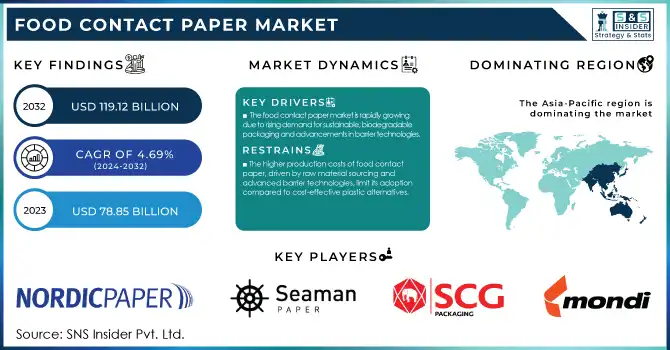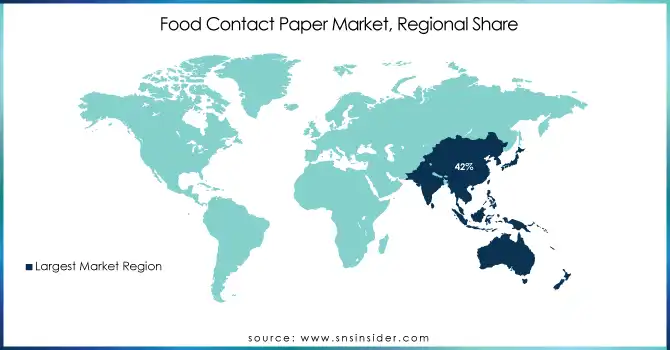Food Contact Paper Market Report Scope & Overview:
The Food Contact Paper Market size was USD 78.85 billion in 2023 and is expected to Reach USD 119.12 billion by 2032 and grow at a CAGR of 4.69% over the forecast period of 2024-2032.

Get More Information on Food contact paper Market - Request Sample Report
The food contact paper market is experiencing significant growth, driven by increasing consumer demand for sustainable and eco-friendly packaging solutions. As environmental concerns rise, both consumers and manufacturers are shifting away from plastic packaging in favor of paper-based alternatives that are biodegradable and recyclable. This transition is further supported by stringent regulatory standards aimed at ensuring food safety and promoting sustainable practices.
Technological advancements have led to the development of food contact papers with enhanced barrier properties, such as improved resistance to grease, moisture, and oil. These innovations have expanded the application of food contact papers across various sectors, including bakery and confectionery, dairy products, fresh produce, and fast food. The versatility and adaptability of these papers make them suitable for packaging a wide range of food items, maintaining product integrity and extending shelf life. Consumer preferences are also influencing market trends, with a growing inclination towards hygienic and convenient packaging. Food contact papers offer a sanitary solution that protects food from contamination while being easy to handle and dispose of, aligning with the modern consumer's lifestyle. Additionally, the ability to customize and brand these papers provides companies with opportunities to enhance product appeal and brand recognition.
Food Contact Paper Market Dynamics
DRIVERS
- The food contact paper market is growing rapidly, driven by increasing demand for sustainable, biodegradable packaging solutions, supported by regulatory mandates and advancements in barrier technologies.
The food contact paper market is witnessing robust growth due to the rising demand for sustainable packaging solutions. Consumers and businesses are increasingly prioritizing eco-friendly alternatives, driving a transition from plastic to biodegradable and recyclable paper-based materials. Approximately 70% of global consumers now prefer products with sustainable packaging, reflecting a significant shift in purchasing behavior. Regulatory frameworks worldwide are also reinforcing this trend, mandating the reduction of plastic waste and encouraging the use of sustainable materials.
Growth in the foodservice sector, particularly in quick-service restaurants and takeaway services, has further fueled the demand for food contact paper. Innovations in barrier technologies have enhanced the performance of these papers, making them greaseproof, moisture-resistant, and suitable for diverse applications, from bakery wraps to fresh produce packaging. This aligns with the broader market trend of combining sustainability with functionality, driving increased adoption and paving the way for continuous innovation in the sector.
RESTRAINT
- The higher production costs of food contact paper, driven by raw material sourcing and advanced barrier technologies, limit its adoption compared to cost-effective plastic alternatives.
The cost-effectiveness of food contact paper compared to plastic remains a significant restraint in its widespread adoption. While food contact paper offers environmental benefits such as biodegradability and recyclability, its production involves higher manufacturing and processing costs. These costs stem from sourcing raw materials like wood pulp and incorporating advanced barrier technologies for grease and moisture resistance. For instance, studies indicate that paper-based packaging can be up to 30% more expensive than plastic counterparts in certain applications, making it less appealing to cost-sensitive businesses. Additionally, the durability and efficiency of plastic packaging, especially for high-moisture or greasy foods, provide a competitive edge in terms of cost and performance. Although consumers increasingly prefer sustainable packaging, businesses often face challenges in balancing environmental responsibility with profitability. Overcoming these cost barriers through innovations in production processes and economies of scale is crucial for driving the broader adoption of food contact paper.
Food Contact Paper Market Segmentation
By Type
The Kraft Paper segment dominated with the market share over 32% in 2023, primarily due to its exceptional versatility and durability. Its robust properties make it suitable for a wide range of food packaging applications, including wrapping, bags, and cartons. Kraft paper is highly favored for its eco-friendly and recyclable nature, aligning with the growing consumer demand for sustainable packaging solutions. Its widespread use across industries such as food service, retail, and grocery further strengthen its dominance.
By Application
The Fresh Produce segment dominated with the market share over 36% in 2023, driven by increasing consumer demand for eco-friendly and sustainable packaging. With heightened awareness of environmental issues, consumers and retailers are prioritizing biodegradable and recyclable materials for packaging fruits, vegetables, and other perishable items. Food contact paper offers excellent breathability and protection, preserving the freshness and quality of produce while reducing the environmental impact. Additionally, regulatory measures and industry initiatives to phase out single-use plastics have further boosted the adoption of paper-based packaging. As a result, fresh produce packaging continues to be the leading application in the food contact paper market.
Food Contact Paper Market Regional Analysis
Asia-Pacific region dominated with the market share over 42% in 2023, driven by a combination of factors including its vast population, rising disposable incomes, and the rapid expansion of the foodservice sector. The region's growing middle class and urbanization have spurred demand for convenient and sustainable food packaging solutions. Countries like China and India play a pivotal role, contributing significantly to the market's dominance due to their booming food and beverage industries and evolving consumer preferences. Additionally, increasing awareness of eco-friendly packaging alternatives has further fueled the adoption of food contact paper, solidifying Asia-Pacific's position as the market leader.
North America is emerging as the fastest-growing market in the food contact paper industry. This growth is primarily driven by a rising consumer preference for sustainable and eco-friendly packaging solutions, reflecting growing environmental awareness. Additionally, stringent regulations and standards regarding food safety and packaging materials are encouraging the adoption of food-safe papers. The demand is further boosted by the region's robust food and beverage sector, increasing focus on reducing plastic waste, and innovations in biodegradable and recyclable packaging.

Get Customized Report as per Your Business Requirement - Request For Customized Report
Some of the major key players of the Food Contact Paper Market
- Mondi Plc (greaseproof paper, baking paper)
- UPM Global (specialty papers for food packaging, flexible packaging)
- KRPA PAPER (wrapping papers, greaseproof papers)
- SCG Packaging PCL (coated food-grade papers, biodegradable packaging)
- Seaman Paper Company (lightweight packaging papers, food wraps)
- BPM Inc (waxed paper, parchment paper)
- Twin Rivers Paper Company (natural kraft paper, specialty food packaging paper)
- WestRock Company (coated paperboard, corrugated packaging)
- Asian Pulp & Paper Company (grease-resistant paper, biodegradable food wraps)
- Nordic Paper (greaseproof paper, parchment paper)
- Georgia-Pacific LLC (food wraps, kraft papers)
- International Paper Company (recyclable food service papers, containerboard)
- Smurfit Kappa Group (sustainable food-grade packaging, kraft paper)
- Stora Enso (renewable packaging papers, barrier-coated papers)
- DS Smith Plc (recyclable paper packaging for food products)
- Ahlstrom-Munksjö (parchment paper, food wraps)
- Oji Holdings Corporation (waxed paper, greaseproof paper)
- Nippon Paper Industries Co., Ltd. (packaging boards, food-grade paper)
- Sappi Limited (coated paper for food packaging, flexible paper solutions)
- BillerudKorsnäs (sustainable food packaging papers, barrier papers)
Suppliers for (high-quality food-grade paper and sustainable packaging solutions) on Food Contact Paper Market
- International Paper Co.
- Smurfit Kappa Group
- Stora Enso
- Twin Rivers Paper Company
- Asia Pulp & Paper
- Mondi Group
- WestRock Company
- UPM-Kymmene Corporation
- DS Smith
- Nippon Paper Industries
RECENT DEVELOPMENT
In June 2023: Mondi and Syntegon introduced an innovative paper packaging solution crafted from recycled fibers. This product features Mondi’s EcoVantage kraft paper, which is spot-coated to provide dust-tight and heat-sealable properties. It is designed for packaging dry foods like sugar, pasta, and flour.
In February 2024: Nippon Paper Industries announced a new subsidiary in Hungary to produce carboxymethyl cellulose (CMC) for lithium-ion battery anodes, with operations starting in December 2024.
| Report Attributes | Details |
| Market Size in 2023 | USD 78.85 Billion |
| Market Size by 2032 | USD 119.12 Billion |
| CAGR | CAGR of 4.69% From 2024 to 2032 |
| Base Year | 2023 |
| Forecast Period | 2024-2032 |
| Historical Data | 2020-2022 |
| Report Scope & Coverage | Market Size, Segments Analysis, Competitive Landscape, Regional Analysis, DROC & SWOT Analysis, Forecast Outlook |
| Key Segments | • By Type (Kraft Paper, Greaseproof Paper, Glassine Paper, Parchment Paper, Others) • By Application (Fresh Produce, Dry Groceries, Bakery Products, Liquid Food and Drinks, Takeaway and Vending Foods, Others) |
| Regional Analysis/Coverage | North America (US, Canada, Mexico), Europe (Eastern Europe [Poland, Romania, Hungary, Turkey, Rest of Eastern Europe] Western Europe] Germany, France, UK, Italy, Spain, Netherlands, Switzerland, Austria, Rest of Western Europe]), Asia Pacific (China, India, Japan, South Korea, Vietnam, Singapore, Australia, Rest of Asia Pacific), Middle East & Africa (Middle East [UAE, Egypt, Saudi Arabia, Qatar, Rest of Middle East], Africa [Nigeria, South Africa, Rest of Africa], Latin America (Brazil, Argentina, Colombia, Rest of Latin America) |
| Company Profiles | Mondi Plc, UPM Global, KRPA PAPER, SCG Packaging PCL, Seaman Paper Company, BPM Inc, Twin Rivers Paper Company, WestRock Company, Asian Pulp & Paper Company, Nordic Paper, Georgia-Pacific LLC, International Paper Company, Smurfit Kappa Group, Stora Enso, DS Smith Plc, Ahlstrom-Munksjö, Oji Holdings Corporation, Nippon Paper Industries Co., Ltd., Sappi Limited, BillerudKorsnäs |
| Key Drivers | • The food contact paper market is growing rapidly, driven by increasing demand for sustainable, biodegradable packaging solutions, supported by regulatory mandates and advancements in barrier technologies. |
| Restraints | • The higher production costs of food contact paper, driven by raw material sourcing and advanced barrier technologies, limit its adoption compared to cost-effective plastic alternatives. |

